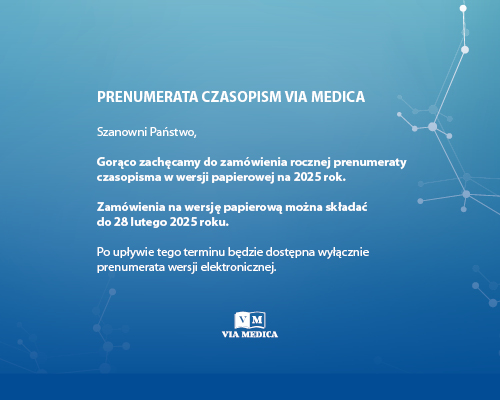Przywracanie rytmu zatokowego u pacjentów z migotaniem przedsionków leczonych doustnymi antykoagulantami niebędącymi antagonistami witaminy K jest bezpieczne bez przezprzełykowego badania echokardiograficznego — doniesienie wstępne
Streszczenie
Wstęp. Migotanie przedsionków (AF) to najczęstszy typ arytmii nadkomorowej. Niefarmakologiczną metodą przywracania zatokowego rytmu serca u chorych z AF jest kardiowersja elektryczna. Pozycja przezprzełykowego badania echokardiograficznego (TEE) u chorych poddawanych kardiowersji elektrycznej nadal nie jest ostatecznie ustalona.
Celem pracy była ocena bezpieczeństwa kardiowersji elektrycznej u pacjentów z AF stosujących co najmniej 21 dni doustne antykoagulanty niebędące antagonistami witaminy K (NOAC), u których kardiowersję elektryczną wykonano bez poprzedzającej TEE.
Materiał i metody. Badaniem objęto 132 chorych leczonych NOAC poddawanych kardiowersji elektrycznej na oddziale kardiologii szpitala powiatowego. Z badania wyłączono chorych z zastawkowym AF oraz nieregularnie przyjmujących NOAC. Oceniono częstość występowania powikłań zakrzepowo-zatorowych oraz krwotocznych w obserwacji 30-dniowej.
Wyniki. W grupie 132 chorych leczonych NOAC 65 chorych (49,2%) otrzymywało riwaroksaban, 62 chorych (47,0%) dabigatran, a 5 chorych apiksaban (3,8%). W okresie szpitalnym i w czasie 30-dniowej obserwacji w badanej grupie nie stwierdzono powikłań zakrzepowo-zatorowych ani powikłań krwotocznych.
Wnioski. Leki z grupy NOAC są skuteczne i bezpieczne w przygotowaniu chorych z AF do kardiowersji elektrycznej. U chorych regularnie stosujących NOAC przez co najmniej 21 dni przed planowanym przywróceniem rytmu zatokowego
Słowa kluczowe: TEEkardiowersja elektrycznaNOAC
Referencje
- Prystowsky EN, Benson D, Fuster V, et al. Management of patients with atrial fibrillation. A statestment for healthcare professionals from the subcommittee on electrocardiography and electrophysiology. American Heart Association. Circulation. 1996; 93(6): 1262–1277.
- Fuster V, Rydén L, Cannom D, et al. ACC/AHA/ESC Guidelines for the management of patients with atrial fibrillation: Executive Summary A Report of the American College of Cardiology/American Heart Association Task Force on Practice Guidelines and the European Society of Cardiology Committee for Practice Guidelines and Policy Conferences (Committee to Develop Guidelines for the Management of Patients With Atrial Fibrillation) Developed in Collaboration with the North American Society of Pacing and Electrophysiology. Circulation. 2001; 104(17): 2118–2150.
- Prevost JL, Battelli F. Sur quelques effets des decharges electriques sur le coeur des mammiferes. CR Acad Sci (Paris. 1899; 129: 1267–1268.
- Gallagher MM, Hennessy BJ, Edvardsson N, et al. Embolic complications of direct current cardioversion of atrial arrhythmias: association with low intensity of anticoagulation at the time of cardioversion. J Am Coll Cardiol. 2002; 40(5): 926–933.
- Nagarakanti R, Ezekowitz MD, Oldgren J, et al. Dabigatran versus warfarin in patients with atrial fibrillation: an analysis of patients undergoing cardioversion. Circulation. 2011; 123(2): 131–136.
- Cappato R, Ezekowitz M, Klein A, et al. Rivaroxaban vs. vitamin K antagonists for cardioversion in atrial fibrillation. Eur Heart J. 2014; 35(47): 3346–3355.
- Flaker G, Lopes RD, Al-Khatib SM, et al. ARISTOTLE Committees and Investigators. Efficacy and safety of apixaban in patients after cardioversion for atrial fibrillation: insights from the ARISTOTLE Trial (Apixaban for Reduction in Stroke and Other Thromboembolic Events in Atrial Fibrillation). J Am Coll Cardiol. 2014; 63(11): 1082–1087.
- Kirchhof P, Benussi S, Kotecha D, et al. ESC Scientific Document Group. 2016 ESC Guidelines for the management of atrial fibrillation developed in collaboration with EACTS. Eur Heart J. 2016; 37(38): 2893–2962.
- Gawałko M, Kapłon-Cieślicka A, Budnik M, et al. Comparison of different oral anticoagulant regimens in patients with atrial fibrillation undergoing ablation or cardioversion. Pol Arch Intern Med. 2017; 127(12): 823–831.
- Frederiksen AS, Albertsen AE, Christesen AM, et al. Cardioversion of atrial fibrillation in a real-world setting: non-vitamin K antagonist oral anticoagulants ensure a fast and safe strategy compared to warfarin. Europace. 2018; 20(7): 1078–1085.
- Papp J, Zima E, Bover R, et al. Changes in oral anticoagulation for elective cardioversion: results from a European cardioversion registry. Eur Heart J Cardiovasc Pharmacother. 2017; 3(3): 147–150.
- Coleman CM, Khalaf S, Mould S, et al. Novel oral anticoagulants for DC cardioversion procedures: utilization and cilnical outcomes compared with warfarin. Pacing Clin Electrophysiol. 2015; 38(6): 731–737.
- Cappato R, Ezekowitz M, Klein A, et al. Rivaroxaban vs. vitamin K antagonists for cardioversion in atrial fibrillation. Eur Heart J. 2014; 35(47): 3346–3355.
- Cozma D, Streian CG, Vacarescu C, et al. Back to sinus rhythm from atrial flutter or fibrillation: dabigatran is safe without transoesophageal control. Kardiol Pol. 2016; 74(5): 425–430.





